
Tiziano Vecelli or Vecellio, Latinized as Titianus, hence known in English as Titian, was an Italian (Venetian) Renaissance painter of Lombard origin, considered the most important member of the 16th-century Venetian school. He was born in Pieve di Cadore, near Belluno. During his lifetime he was often called da Cadore, 'from Cadore', taken from his native region.

Diana and Actaeon is a painting by the Italian Renaissance master Titian, finished in 1556–1559, and is considered amongst Titian's greatest works. It portrays the moment in which the hunter Actaeon bursts in where the goddess Diana and her nymphs are bathing. Diana is furious, and will turn Actaeon into a stag, who is then pursued and killed by his own hounds, a scene Titian later painted in his The Death of Actaeon.

Diana and Callisto is a painting completed between 1556 and 1559 by the Italian late Renaissance artist Titian. It portrays the moment in which the goddess Diana discovers that her maid Callisto has become pregnant by Jupiter. The painting was jointly purchased by the National Gallery and the Scottish National Gallery for £45 million in March 2012. Along with its companion painting Diana and Actaeon it is displayed on an alternating basis between London and Edinburgh. There is a later version by Titian and his workshop in the Kunsthistorisches Museum in Vienna.

The Death of Actaeon is a late work by the Italian Renaissance painter Titian, painted in oil on canvas from about 1559 to his death in 1576 and now in the National Gallery in London. It is very probably one of the two paintings the artist stated he had started and hopes to finish in a letter to their commissioner Philip II of Spain during June 1559. However, most of Titian's work on this painting possibly dates to the late 1560s, but with touches from the 1570s. Titian seems never to have resolved it to his satisfaction, and the painting apparently remained in his studio until his death in 1576. There has been considerable debate as to whether it is finished or not, as with other very late Titians, such as the Flaying of Marsyas, which unlike this has a signature, perhaps an indication of completion.

The Eleven Caesars was a series of eleven painted half-length portraits of Roman emperors made by Titian in 1536-1540 for Federico II, Duke of Mantua. They were among his best-known works, inspired by the Lives of the Caesars by Suetonius. Titian's paintings were originally housed in a new room inside the Palazzo Ducale di Mantova. Bernardino Campi added a twelfth portrait in 1562.

The Venetian painter Titian and his workshop made at least six versions of the same composition showing Danaë, painted between about 1544 and the 1560s. The scene is based on the mythological princess Danaë, as – very briefly – recounted by the Roman poet Ovid, and at greater length by Boccaccio. She was isolated in a bronze tower following a prophecy that her firstborn would eventually kill her father. Although aware of the consequences, Danaë was seduced and became pregnant by Zeus, who, inflamed by lust, descended from Mount Olympus to seduce her in the form of a shower of gold.
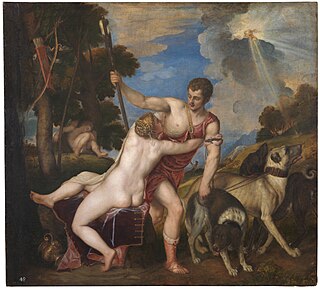
A composition of Venus and Adonis by the Venetian Renaissance artist Titian has been painted a number of times, by Titian himself, by his studio assistants and by others. In all there are some thirty versions that may date from the 16th century, the nudity of Venus undoubtedly accounting for this popularity. It is unclear which of the surviving versions, if any, is the original or prime version, and a matter of debate how much involvement Titian himself had with surviving versions. There is a precise date for only one version, that in the Prado in Madrid, which is documented in correspondence between Titian and Philip II of Spain in 1554. However, this appears to be a later repetition of a composition first painted a considerable time earlier, possibly as early as the 1520s.
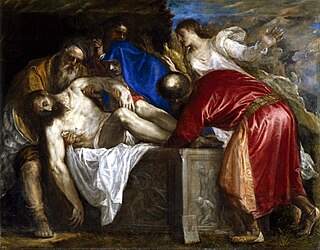
The Entombment is a 1559 oil-on-canvas painting by the Venetian painter Titian, commissioned by Philip II of Spain. It depicts the burial of Jesus in a stone sarcophagus, which is decorated with depictions of Cain and Abel and the binding of Isaac. The painting measures 137 cm × 175 cm and is now in the Museo del Prado in Madrid. Titian made several other paintings depicting the same subject, including a similar version of 1572 given as a gift to Antonio Pérez and now also in the Prado, and an earlier version of c.1520 made for the Duke of Mantua and now in the Louvre.

Venus with a Mirror is a painting by Titian, now in the National Gallery of Art in Washington, DC, and it is considered to be one of the collection's highlights.
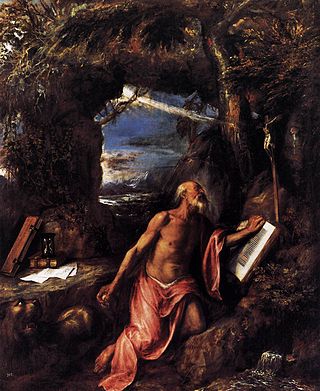
Saint Jerome in Penitence is a c.1575 painting of Saint Jerome by Titian, now in the Nuevos Museos in the El Escorial. It was painted for King Philip II.
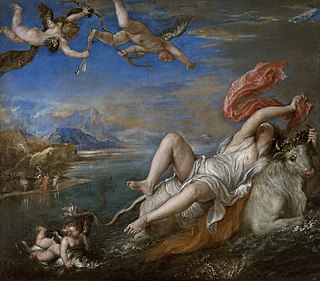
The Rape of Europa is a painting by the Venetian artist Titian, painted ca. 1560–1562. It is in the permanent collection of the Isabella Stewart Gardner Museum of Boston, Massachusetts. The oil-on-canvas painting measures 178 by 205 centimetres.

Religion saved by Spain is an oil on canvas painting produced between 1572 and 1575 by Titian, an Italian master of the Venetian school, commemorating the Battle of Lepanto in 1571. It is one of his later works, and is considered to be an outstanding piece. Other titles are Spain succoring Religion or Religion assisted by Spain.

La Gloria is a painting by Titian, commissioned by Charles V in 1550 or 1551 and completed in 1554. It was first given this title by José Sigüenza in 1601 — it is also known as The Trinity, The Final Judgement, Paradise, and Adoration of the Trinity.
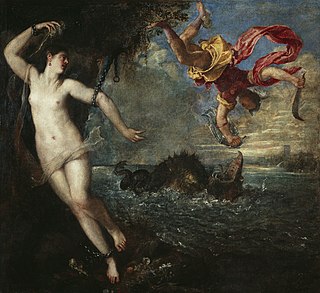
Perseus and Andromeda is a painting by the Italian Renaissance artist Titian, now in the Wallace Collection in London. It was painted in 1554–1556 as part of a series of mythological paintings called "poesie" ("poetry") intended for King Philip II of Spain. The paintings took subjects from the Roman poet Ovid's Metamorphoses, in this case Book IV, lines 663–752, and all featured female nudes.

The Pardo Venus is a painting by the Venetian artist Titian, completed in 1551 and now in the Louvre Museum. It is also known as Jupiter and Antiope, since it seems to show the story of Jupiter and Antiope from Book VI of the Metamorphoses. It is Titian's largest mythological painting, and was the first major mythological painting produced by the artist for Philip II of Spain. It was long kept in the Royal Palace of El Pardo near Madrid, hence its usual name; whether Venus is actually represented is uncertain. It later belonged to the English and French royal collections.

Portrait of Philip II is an oil on canvas portrait by Titian of Philip II of Spain wearing the chain of the Order of the Golden Fleece. It is in the collection of the Museo di Capodimonte, in Naples.
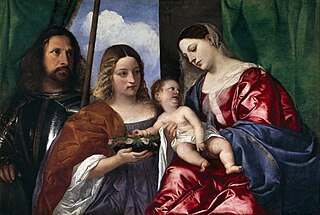
The Virgin and Child with Saints Dorothy and George is a c.1516 oil on panel painting by Titian, now in the Prado Museum in Madrid, to which it was transferred in 1839.

Salome, also known as Salome with the Head of John the Baptist, is an oil painting by the Venetian painter Titian, made in about 1550, and currently in the collection of the Museo del Prado in Madrid. It is not to be confused with other compositions of Salome and Judith by Titian.
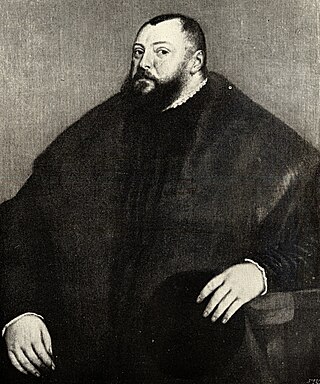
Portrait of John Frederick I, Elector of Saxony is an oil painting by the Venetian painter Titian, made in late 1550 or early 1551. The painting is in the collection of the Kunsthistorisches Museum in Vienna.

Salome, also called Salome with the Head of John the Baptist, is an oil painting by Titian, made in around 1570, and currently in a private collection. It is not to be confused with other compositions of Salome and Judith by Titian.




















